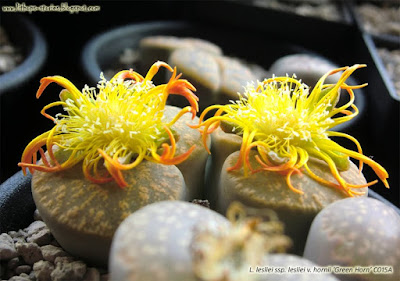I was excited to see this flower since some time now knowing it should be intense yellow with large white center, but it grew really slowly. With other lithops flowers I had it was always very quick when there's a lot of sun! We had nice sunny days lately with other lithops flowering but this helmutii wasn't easily persuaded. The last couple of days it was gloomy-rainy and, what would you know, the bud grew and swelled and opened as soon as the sun came out again.
It's not only the flower but the whole flower-plant color contrast I like. So pretty! :)

It is alone at the moment but the lovely japanese "yellow edge"-helmutii are in hot persuit. Well, as 'hot' as it can get with helmutii, haha, considering how long it took the other plant. It is not visible on the pictures but each has two flower buds to boast so far.













































